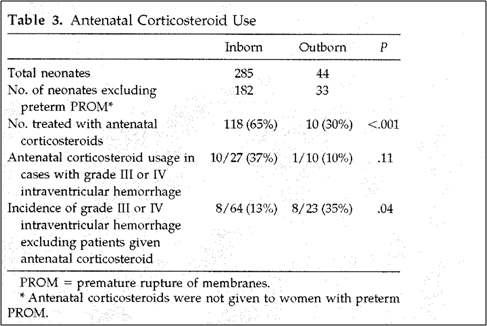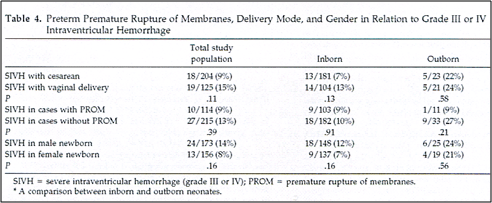Failure To Diagnose Preterm Labor And Transfer To A Level III Tertiary Care Center
When a pregnant woman presents to a hospital with cramping, vaginal discharge or bleeding, preterm labor must be the presumptive diagnosis until ruled out. This is especially true when the hospital is not capable of properly resuscitating and caring for a preterm baby (less than 34 weeks’ gestation).
Regionalized System Of Perinatal Care
Like many states, Iowa has a regionalized system of perinatal health care that was established pursuant to Iowa Code §135.11 and Iowa Administrative Code 641-150.1. Along with this regionalized system, the Iowa Department of Public Health has published “Guidelines for Perinatal Services.” These guidelines identify their intent as follows:
“The intent of Guidelines for Perinatal Services is to assure that when a hospital markets itself at a particular level of perinatal care, it is capable of providing that care. The public is entitled to know the level of functioning. A hospital having determined to participate in the regionalized system of perinatal care shall comply with the guidelines appropriate to the level of participation selected by the hospital and approved by the advisory committee for perinatal guidelines.”
Guidelines For Perinatal Services, Eighth Edition, 2008.
This regionalized system identifies levels of hospitals depending on the level of care that can be provided to term babies or preterm babies. The levels and the hospitals in each level are as follows:
- Level I Hospital
- Level II Hospital
- Level II Regional Center
- Level II Regional Neonatology Center
- Level III Center
Level I hospitals are small county or community hospitals that provide normal or routine obstetrical care, but are not equipped to care for premature babies. Since the majority of the cases we see arise from problems that develop at Level I hospitals, the remainder of this article will address Level I facilities and the need to transfer a woman in preterm labor to a Level II or Level III facility.
Level I Hospital Requirements
If a hospital is going to hold itself out as a Level I hospital, it is required to have the capability to:
- Provide surveillance and care of all patients admitted to the obstetric service with an established triage system for identifying high-risk patients who should be transferred to a facility that provides Level II or higher care, prior to delivery
- Provide proper detection and supportive care of unanticipated maternal-fetal problems that occur during labor and delivery
- Perform emergency cesarean sections as soon as possible after the decision to do the operation has been made
- Provide transfusions of blood and fresh frozen plasma on a 24-hour basis
- Provide anesthesia, pharmacy, radiology, respiratory support, electronic fetal heart-rate monitoring, and laboratory services on a 24-hour basis
- Provide care of postpartum conditions
- Evaluate the condition of healthy neonates and their continuing care until discharge
- Resuscitate all neonates using the neonatal resuscitation program guidelines as established by the American Heart Association/American Academy of Pediatrics
- Stabilize all neonates, including unexpectedly small or sick neonates, before transfer
- Consult and arrange transfers in conjunction with the obstetrician, pediatrician or neonatologist at the referral center
- Maintain a nursery for normal term or near-term newborns
Guidelines For Perinatal Services, Eighth Edition, 2008, p.5. Although the above requirements have been the primary interest in the cases we have handled, the Guidelines do set out other requirements for Level I hospitals.
Level I Hospitals In Iowa
On 4/15/09, the Iowa Department of Public Health identified the following hospitals as Level I Hospitals in the State of Iowa:
- Kossuth Regional Health Center, Algona
- Cass County Memorial Hospital, Atlantic
- Davis County Hospital, Bloomfield
- Boone County Hospital, Boone
- St. Anthony Regional Hospital, Carroll
- Mercy Medical Center, Centerville
- Lucas County Health Center, Chariton
- Floyd County Memorial Hospital, Charles City
- Sioux Valley Memorial Hospital, Cherokee
- Wright Medical Center, Clarion
- Wayne County Hospital, Corydon
- Mercy Hospital, Council Bluffs
- Regional Health Services of Howard County, Cresco
- Greater Community Hospital, Creston
- Trinity at Terrace Park, Bettendorf
- Winneshiek County Memorial Hospital, Decorah
- Crawford County Memorial Hospital, Denison
- Broadlawns Medical Center, Des Moines
- Iowa Lutheran Hospital, Des Moines
- Palo Alto County Heath System, Emmetsburg
- Fort Madison Community Hospital, Fort Madison
- Grinnell Regional Medical Center, Grinnell
- Guttenberg Municipal Hospital, Guttenberg
- Myrtue Memorial Hospital, Harlan
- Horn Memorial Hospital, Ida Grove
- Ellsworth Municipal Hospital, Iowa Falls
- Greene County Medical Center, Jefferson
- Keokuk Area Hospital, Keokuk
- Van Buren County Hospital, Keosauqua
- Knoxville Area Community Hospital, Knoxville
- Stewart Memorial Community Hospital, Lake City
- Floyd Valley Hospital, LeMars
- Regional Medical Center of NE Iowa and Delaware County, Manchester
- Manning Regional Healthcare Center, Manning
- Jackson County Public Hospital, Maquoketa
- Henry County Health Center, Mount Pleasant
- Unity Health Care, Muscatine
- Skiff Medical Center, Newton
- Burgess Health Center, Onawa
- Orange City Health System, Orange City
- Mahaska Hospital, Oskaloosa
- Pella Regional Health Center, Pella
- Montgomery County Memorial Hospital, Red Oak
- Sanford Hospital, Rock Rapids
- Hegg Memorial Health Center, Rock Valley
- Sanford Sheldon Medical Center, Sheldon
- Shenandoah Medical Center, Shenandoah
- Osceola Community Hospital, Inc., Sibley
- Sioux Center Community Hospital/Health Center, Sioux Center
- Spencer Hospital, Spencer
- Dickinson County Memorial Hospital, Spirit Lake
- Buena Vista Regional Medical Center, Storm Lake
- Washington County Hospital and Clinics, Washington
- Veterans Memorial Hospital, Waukon
- Waverly Municipal Hospital, Waverly
- Hamilton Hospital, Webster City
- Palmer Lutheran Health Center, West Union
When To Transfer A Patient Suspected To Be In Preterm Labor
When a woman presents to a Level I hospital with cramping, vaginal discharge or bleeding, preterm labor must be the presumptive diagnosis until it can be ruled out. If the Level I hospital is not able to rule out preterm labor, then the recommendation is that the patient be immediately transferred to a Level II or Level III hospital. Physicians we have deposed agree with the phrase: “When in doubt, ship them out.”
In a case we handled for a client that presented to a Level I Hospital with complaints of cramping, discharge and bleeding, the Level I hospital failed to diagnose preterm labor. The client was placed in outpatient observation for approximately 10 hours. After 10 hours, she had a spontaneous delivery of a 26-week-old neonate in her hospital bed.
On the issue of transfer to a tertiary care center, one of the experts we retained in maternal fetal medicine stated:
“With respect to the failure to transfer [Mom] to a tertiary care center and the beneficial effects such transfer would have had on [Baby], the medical evidence is clear and overwhelming. As stated in Neurology of the Newborn, Fourth Edition, (2001):
As with many neonatal neurological disorders, the primary goal in management of IVH [ Intraventricular Hemorrhage ] is prevention.
****
Transportation in utero. If premature labor and delivery cannot be prevented, then transportation of the pregnant woman to a perinatal center specializing in high-risk deliveries should be carried out. Infants thus transported in utero have a considerably lower incidence of IVH than apparently similar infants transported after delivery. *** [p. 462]
In The Effect of Transport on the Rate of Severe Intraventricular Hemorrhage in Very Low Birth Weight Infants, Obstetrics & Gynecology, 2000; 95: 291-295, the following was reported:
Several investigators reported a decrease in neonatal mortality when very low birth weight (VLBW) infants were delivered in level III institutions. There also were reports of less morbidity and improved survival with maternal transport compared with neonatal transport. …
***
Newborns delivered at level I facilities and transported to a level III institution were compared with neonates delivered at the level III center. [p. 291].
***
Results:
There were 37 cases (11 percent) of grade III or IV intraventricular hemorrhage in the 329 newborns who met study criteria: 27 of 285 delivered in the level III center (9 percent), and 10 of 44 outborn neonates (23 percent), a statistically lower difference. [p. 292)
***
Discussion:
… Our data found that the rate of grade III or IV intraventricular hemorrhage is lower in the complicated pregnancies delivered in a level III facility. …
***
Use of antenatal corticosteroids was higher in the inborn population, which probably led to a better outcome. … Use of antenatal corticosteroids in cases with grade III or IV intraventricular hemorrhage was not different, and the rate was still higher in the outborn group on analysis of populations excluding those given antenatal corticosteroids (Table 3). Therefore, antenatal corticosteroids were not the only factor involved in the lower rate of grade III of IV intraventricular hemorrhage in the inborn neonates.


From Table 4 of the above article, you can see that only 7 percent of females born in a tertiary care center suffered from severe IVH compared to 21 percent of females born at a level I hospital. Thus, [Baby] would have benefited from a threefold reduction in the risk of suffering from severe IVH if [Mom] had simply been transferred to the [the Level III hospital].”
Conclusion
In our experience, when a Level I hospital fails to diagnose preterm labor and fails to transfer the obstetrical patient to a Level II or Level III hospital, this failure increases the risk of injury to the newborn baby who is born prematurely at less than 34 weeks’ gestation. If this has occurred and if the infant has suffered permanent physical injuries as a result of prematurity, the parents should seek legal guidance.
